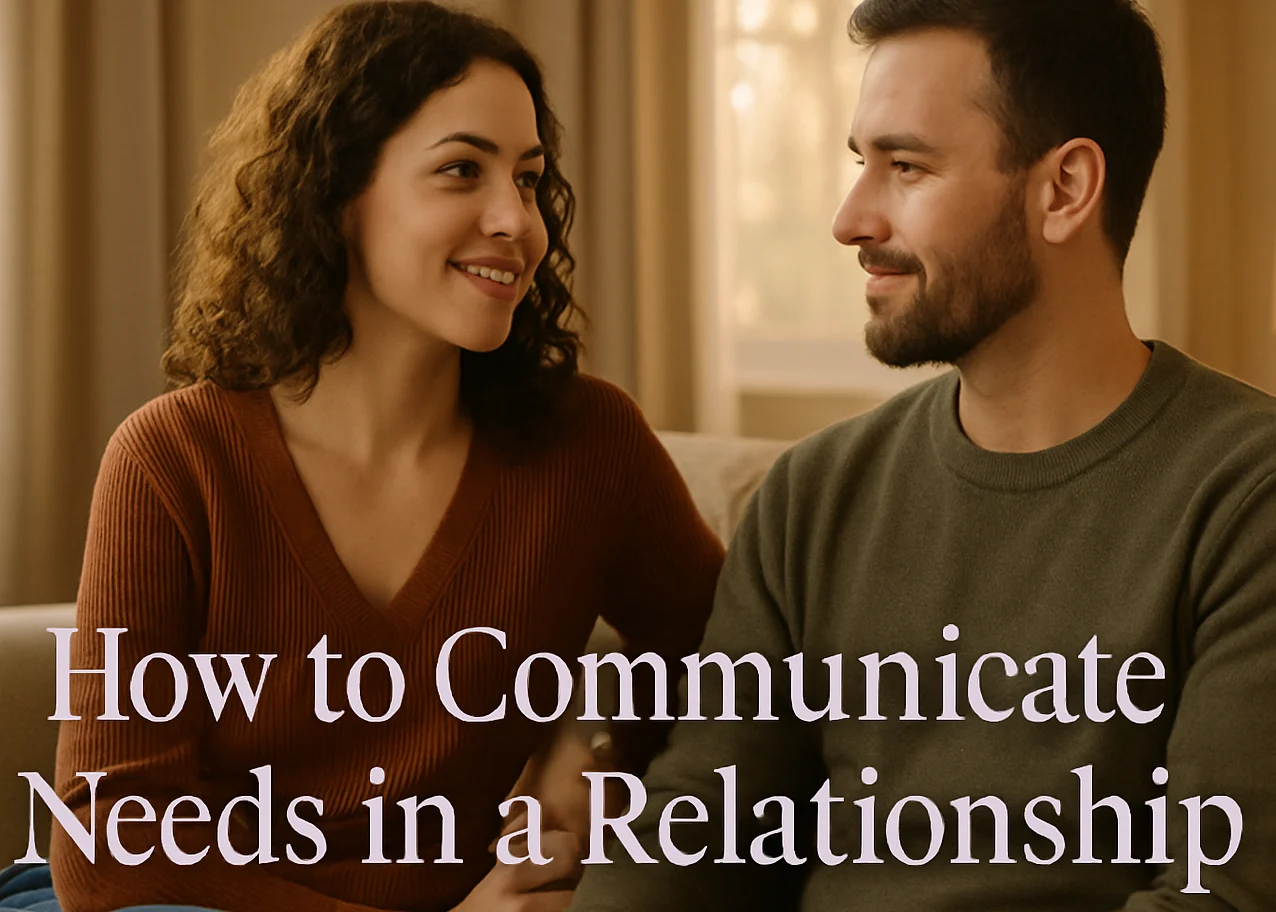
Picture this: ever worry you’ll come off as “too much” or feel like your needs just get brushed off? trust me, I’ve been there, and it’s tough. but learning how to communicate needs in a relationship clearly and kindly can totally change the game. we’re here to guide you, step by step, to speak up with confidence, build a stronger bond, and feel truly heard. ready to make your relationship even better? let’s jump in! for more ways to strengthen your bond, check out our guide on intimacy exercises for couples.
craft your perfect statement!table of contents
- how to communicate needs in a relationship: know your core needs
- overcoming barriers to how to communicate needs in a relationship
- how to communicate needs in a relationship with i statements
- timing and delivery for how to communicate needs in a relationship
- handling dismissal when sharing needs
- frequently asked questions
- conclusion: your voice matters
how to communicate needs in a relationship: know your core needs
to master how to communicate needs in a relationship, you first need to know what they are. it’s like making a grocery list—you’ve got to be clear to get what you need. many women are taught to put others first, often ignoring their own desires. but your needs matter and are key to a happy relationship. let’s explore how to communicate needs in a relationship by starting with self-awareness, which pairs beautifully with data-backed self-love practices.

why identifying needs matters
knowing your needs sets the stage for clear communication in relationships. here’s why it’s a big deal:
- clarity: understanding your needs helps you practice how to communicate needs in a relationship clearly, avoiding mix-ups.
- self-respect: valuing your needs shows you respect yourself.
- stronger bonds: meeting both partners’ needs builds balance and joy.
- less resentment: speaking up about unmet needs stops frustration from piling up.
emotional vs. physical needs
needs aren’t just wants or demands—they’re what you need to feel safe, loved, and fulfilled. here’s a quick breakdown to help you learn how to communicate needs in a relationship:
emotional needs examples:
- feeling heard: you need your partner to listen without cutting you off.
- feeling understood: you want your perspective valued, even if they don’t agree.
- feeling appreciated: you need recognition for what you do.
- feeling safe: emotional and physical security is non-negotiable.
- feeling supported: you need a partner who’s got your back in tough times.
- affection: hugs or closeness make you feel loved.
- quality time: time together strengthens your connection.
- independence: space for hobbies or friendships is essential.
physical needs examples:
- rest: enough sleep or downtime to recharge.
- personal space: time alone to catch your breath.
- physical affection: touch that builds closeness.
- help with tasks: support with chores or responsibilities.
how to identify your needs
start by reflecting on yourself to get better at how to communicate needs in a relationship. grab a journal and ask these questions:
- when do i feel most loved and connected? what actions or words make it happen?
- when do i feel disconnected or frustrated? what’s missing?
- what drains my energy? what would help me feel supported?
- what makes me feel respected or disrespected?
- what one change would make my day or week better?
- in a recent argument, what need felt ignored?
- what makes me feel safe and secure?
“knowing yourself is the first step to speaking up. you can’t ask for what you don’t understand.”
pro tip: feelings like frustration or sadness are clues to unmet needs. listen to them—they’re like your heart’s alarm bells when figuring out how to communicate needs in a relationship!
take your time here—it’s the bedrock for clear communication in relationships.
overcoming barriers to how to communicate needs in a relationship
even when you know what you need, saying it out loud can feel scary. let’s figure out what’s holding you back so you can master how to communicate needs in a relationship with confidence.
common communication blockers for women
- fear of conflict: “if I speak up, we’ll fight, and I hate fighting.” avoiding tough talks can block your ability to practice how to communicate needs in a relationship.
- fear of rejection: “what if they don’t care or walk away?” this fear can keep you quiet.
- guilt or selfishness: “I shouldn’t burden them.” society often pushes women to put others first.
- past trauma: being ignored or shouted down before can make speaking up feel risky.
- “they should know” myth: expecting your partner to read your mind leads to frustration.
- lack of skills: “I don’t know how to say it without sounding pushy.” this guide will help you learn how to communicate needs in a relationship!
- low self-worth: “my needs don’t matter.” believing this stops you from advocating for yourself.
addressing your blockers
- self-reflection: ask, “what’s the worst that could happen if I speak up?”
- name it: pinpointing fears (e.g., “I’m scared they’ll get mad”) takes away their power.
- challenge thoughts: is the worst-case scenario likely? what’s the best that could happen?
- be kind to yourself: it’s okay to feel nervous—you’re not weak.
- start small: try voicing a small need to build confidence in how to communicate needs in a relationship.
getting past these hurdles lets you speak up with ease. for extra help, try our mindfulness retreats to find your inner calm when practicing how to communicate needs in a relationship.

how to communicate needs in a relationship with i statements
now that you’ve pinned down your needs and what’s stopping you, let’s talk about how to say them. i statements are a game-changer for expressing needs clearly without making your partner defensive.
why “you” statements don’t work
saying “you never help!” or “you always ignore me!” often backfires because:
- they feel like blame, putting your partner on edge.
- they start arguments instead of understanding.
- words like “never” or “always” sound unfair.
the power of i statements
i statements put the focus on your feelings and needs, building connection. the formula for how to communicate needs in a relationship is: “i feel [emotion] when [situation], and i need [specific request].”
here’s how it works:
- “i feel [emotion]”: use words like sad, overwhelmed, or unappreciated.
- “when [situation]”: describe the specific behavior factually.
- “i need [request]”: clearly state your need.
example: “i feel overwhelmed when dishes pile up in the sink, and i need help keeping the kitchen tidy.”
“the goal isn’t to win an argument—it’s to create understanding and closeness.”
tips for effective i statements
- be specific: say “i need help with laundry on tuesdays” instead of “i need more help.”
- focus on positives: highlight what you want, not what you don’t.
- keep it short: don’t ramble to keep their attention.
- practice: rehearse to make i statements feel natural for how to communicate needs in a relationship.
ready to give i statements a try? use our interactive tool below to practice how to communicate needs in a relationship! for more ways to grow closer, check out our bonding exercises for couples.
relationship needs script builder
pick an emotion and need to craft a clear i statement for better communication.
understanding the language colors:
- gray: vague or passive. doesn’t clearly state the need or who should act.
- yellow: clearer, needs polish. states a need but may imply blame.
- green: assertive but kind. ✅ uses i statements and is specific.
- red: defensive or blame-heavy. focuses on what the other person did wrong.
💡 tip: to make your statement shine, keep it specific and use the “i feel… i need…” format to share needs effectively.
timing and delivery for how to communicate needs in a relationship
how you say something matters as much as what you say. getting the timing, tone, and body language right is key to sharing needs effectively.
choosing the right moment
- when not to talk:
- when you’re stressed, hungry, or tired (halt: hungry, angry, lonely, tired).
- in the heat of an argument.
- when you’re rushed or distracted.
- when to talk:
- when you’re both calm and relaxed.
- during quiet, private moments (e.g., after dinner).
- pro tip: set it up: “can we chat for 15 minutes tonight?”
tone of voice
your tone sets the vibe for how to communicate needs in a relationship:
- avoid: yelling, sarcasm, or demanding tones.
- aim for: calm, steady, respectful, and confident.
body language and delivery
- make eye contact to show you mean it.
- use open posture—don’t cross your arms.
- keep a relaxed face, not an angry one.
- listen to their response, asking, “does that make sense?”
practice tips
- rehearse in your head or in front of a mirror.
- try it with a friend for feedback.
- start with small needs to get comfortable practicing how to communicate needs in a relationship.
think of these talks as a team effort to make your relationship stronger.

handling dismissal when sharing needs
it’s tough when your needs are brushed off, but don’t give up. here are ways to make sure you’re heard when practicing how to communicate needs in a relationship. if you’re dealing with intimacy challenges after surgery, our guide on intimacy after mastectomy can offer extra support.
re-evaluate the situation
- was it a misunderstanding? check if they really got what you meant.
- was the timing off? look back at section 4 for tips on how to communicate needs in a relationship.
- is your partner overwhelmed? it doesn’t justify dismissal but might explain it.
reiterate clearly
- try again with i statements: “i still feel overwhelmed with chores. i need help with laundry on thursdays.”
- ask for clarity: “what did you hear me say?”
- share the impact: “without rest, I’m grumpy, and it affects us.”
set boundaries
boundaries protect you, not control your partner. for example, when learning how to communicate needs in a relationship:
- “if I’m cleaning alone, I’ll hire a cleaner, and we’ll tweak our budget.”
- “i need 30 minutes to unwind after work, or I’ll remind you to wait.”
stick to your boundaries to show you’re serious.
seek external help
if your needs keep getting ignored, professional help can make a difference. the gottman institute has solid, research-backed tips for couples working on communication. or try our couple’s therapy exercises guide for practical ways to boost how to communicate needs in a relationship.
- individual therapy: build confidence and sort through emotions.
- couples therapy: a safe space to improve communication.
evaluate relationship health
if your needs are constantly ignored, ask yourself:
- does this relationship give me respect and safety?
- can I be my true self?
- am I okay living with unmet needs?
you deserve a relationship where your efforts to practice how to communicate needs in a relationship are valued.
frequently asked questions
conclusion: your voice matters
getting good at how to communicate needs in a relationship feels empowering. it’s about valuing yourself and building a partnership where you both shine. your needs aren’t a burden—they’re part of you. with a bit of courage and practice, you’ll boost your relationship and confidence. go out there and make yourself heard with how to communicate needs in a relationship! ✨